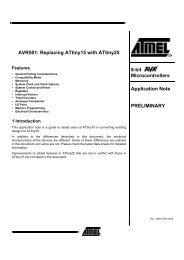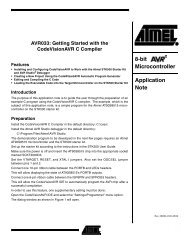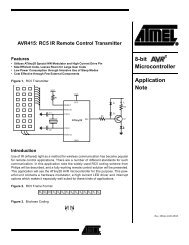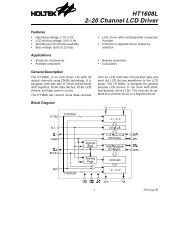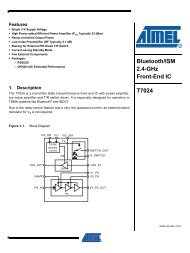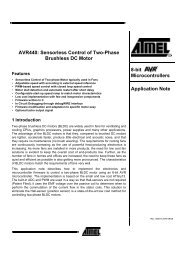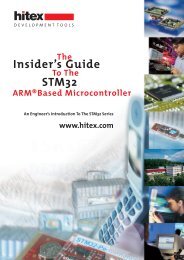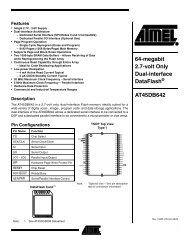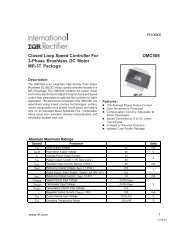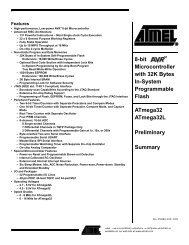Preliminary C8051F120/1/2/3 C8051F124/5/6/7 - KEMT FEI TUKE
Preliminary C8051F120/1/2/3 C8051F124/5/6/7 - KEMT FEI TUKE
Preliminary C8051F120/1/2/3 C8051F124/5/6/7 - KEMT FEI TUKE
You also want an ePaper? Increase the reach of your titles
YUMPU automatically turns print PDFs into web optimized ePapers that Google loves.
<strong>C8051F120</strong>/1/2/3<br />
<strong>C8051F124</strong>/5/6/7<br />
<strong>Preliminary</strong><br />
12.7. Interrupt Handler<br />
The CIP-51 includes an extended interrupt system supporting a total of 20 interrupt sources with two priority levels.<br />
The allocation of interrupt sources between on-chip peripherals and external input pins varies according to the specific<br />
version of the device. Each interrupt source has one or more associated interrupt-pending flag(s) located in an<br />
SFR. When a peripheral or external source meets a valid interrupt condition, the associated interrupt-pending flag is<br />
set to logic 1.<br />
If interrupts are enabled for the source, an interrupt request is generated when the interrupt-pending flag is set. As<br />
soon as execution of the current instruction is complete, the CPU generates an LCALL to a predetermined address to<br />
begin execution of an interrupt service routine (ISR). Each ISR must end with an RETI instruction, which returns program<br />
execution to the next instruction that would have been executed if the interrupt request had not occurred. If<br />
interrupts are not enabled, the interrupt-pending flag is ignored by the hardware and program execution continues as<br />
normal. (The interrupt-pending flag is set to logic 1 regardless of the interrupt's enable/disable state.)<br />
Each interrupt source can be individually enabled or disabled through the use of an associated interrupt enable bit in<br />
an SFR (IE-EIE2). However, interrupts must first be globally enabled by setting the EA bit (IE.7) to logic 1 before the<br />
individual interrupt enables are recognized. Setting the EA bit to logic 0 disables all interrupt sources regardless of<br />
the individual interrupt-enable settings.<br />
Some interrupt-pending flags are automatically cleared by the hardware when the CPU vectors to the ISR. However,<br />
most are not cleared by the hardware and must be cleared by software before returning from the ISR. If an interruptpending<br />
flag remains set after the CPU completes the return-from-interrupt (RETI) instruction, a new interrupt<br />
request will be generated immediately and the CPU will re-enter the ISR after the completion of the next instruction.<br />
12.7.1. MCU Interrupt Sources and Vectors<br />
The MCUs support 20 interrupt sources. Software can simulate an interrupt event by setting any interrupt-pending<br />
flag to logic 1. If interrupts are enabled for the flag, an interrupt request will be generated and the CPU will vector to<br />
the ISR address associated with the interrupt-pending flag. MCU interrupt sources, associated vector addresses, priority<br />
order and control bits are summarized in Table 12.4. Refer to the datasheet section associated with a particular onchip<br />
peripheral for information regarding valid interrupt conditions for the peripheral and the behavior of its interrupt-pending<br />
flag(s).<br />
12.7.2. External Interrupts<br />
Two of the external interrupt sources (/INT0 and /INT1) are configurable as active-low level-sensitive or active-low<br />
edge-sensitive inputs depending on the setting of bits IT0 (TCON.0) and IT1 (TCON.2). IE0 (TCON.1) and IE1<br />
(TCON.3) serve as the interrupt-pending flag for the /INT0 and /INT1 external interrupts, respectively. If an /INT0 or<br />
/INT1 external interrupt is configured as edge-sensitive, the corresponding interrupt-pending flag is automatically<br />
cleared by the hardware when the CPU vectors to the ISR. When configured as level sensitive, the interrupt-pending<br />
flag follows the state of the external interrupt's input pin. The external interrupt source must hold the input active until<br />
the interrupt request is recognized. It must then deactivate the interrupt request before execution of the ISR completes<br />
or another interrupt request will be generated.<br />
Page 144<br />
DS008-0.8-AUG02 © 2002 Cygnal Integrated Products, Inc.



